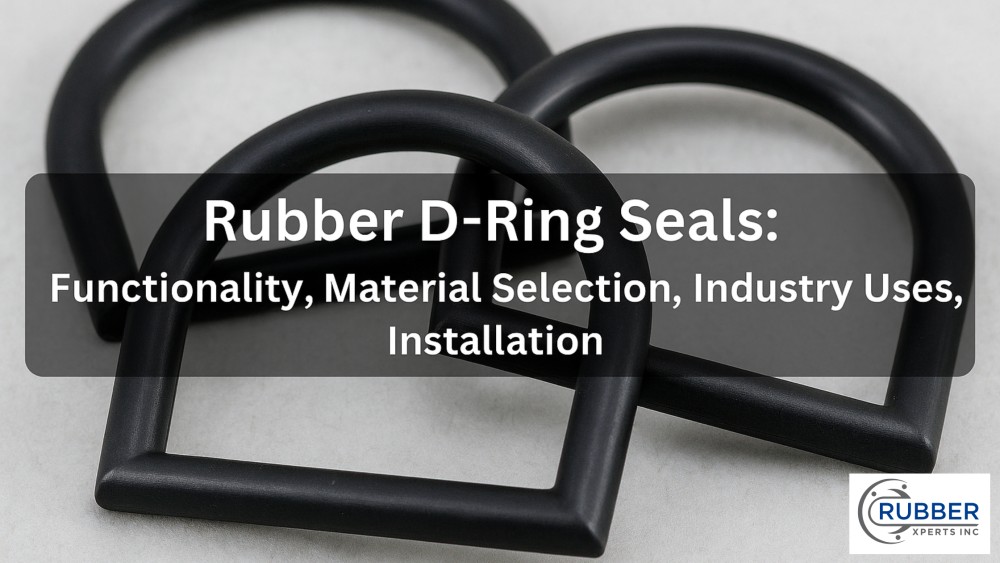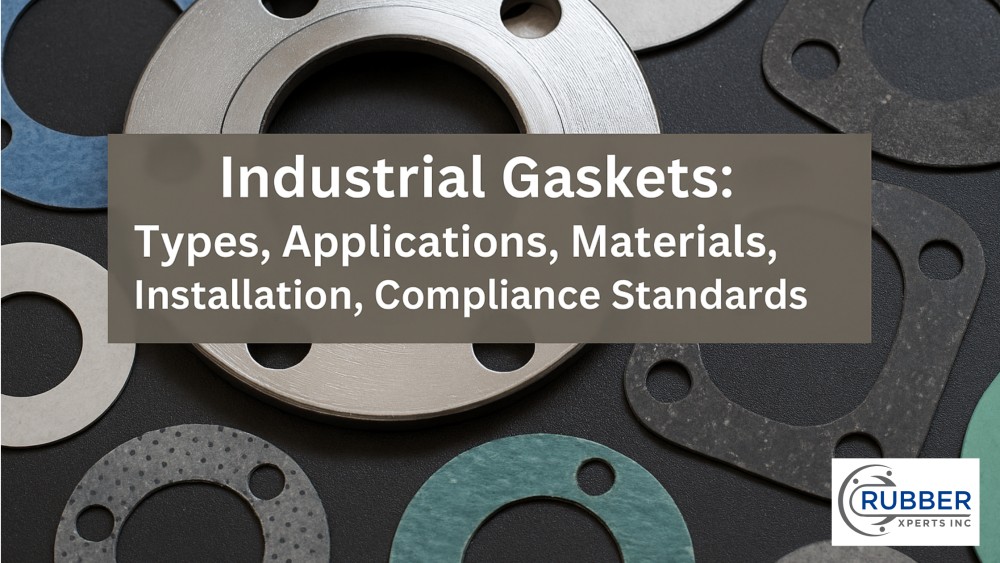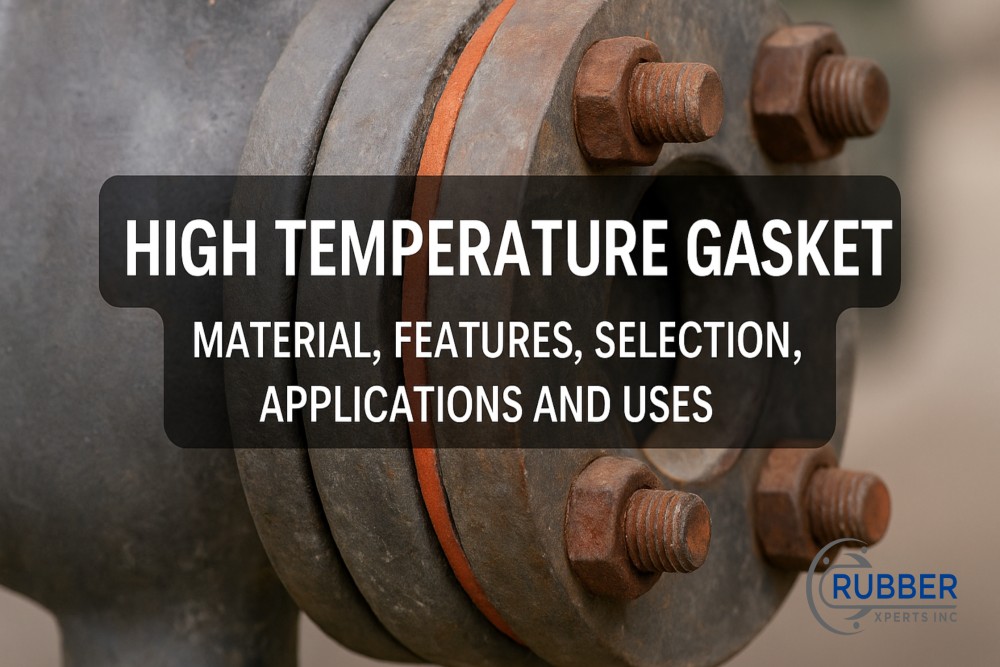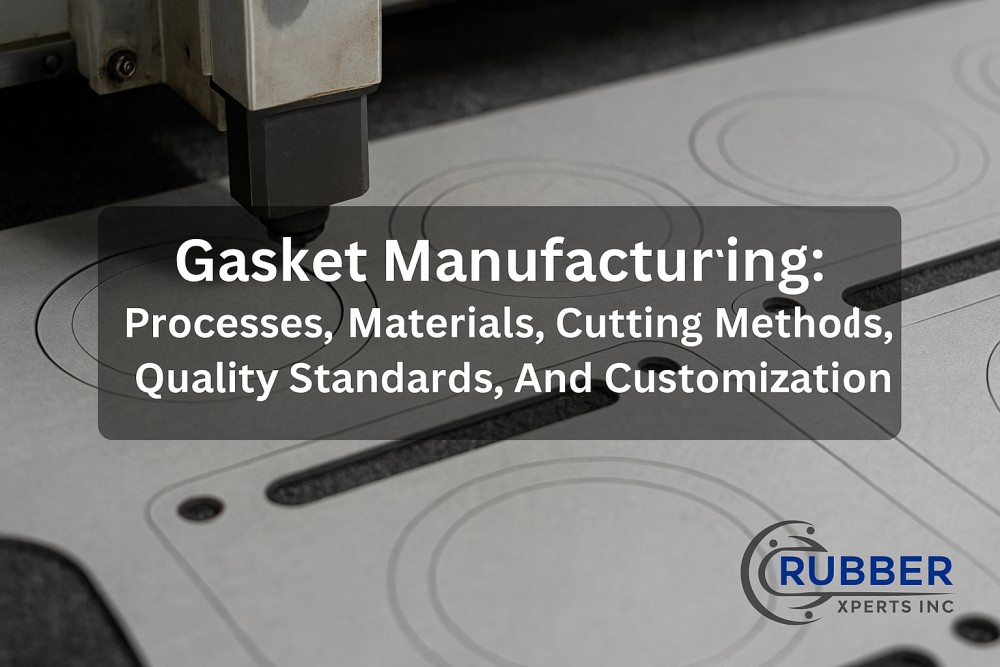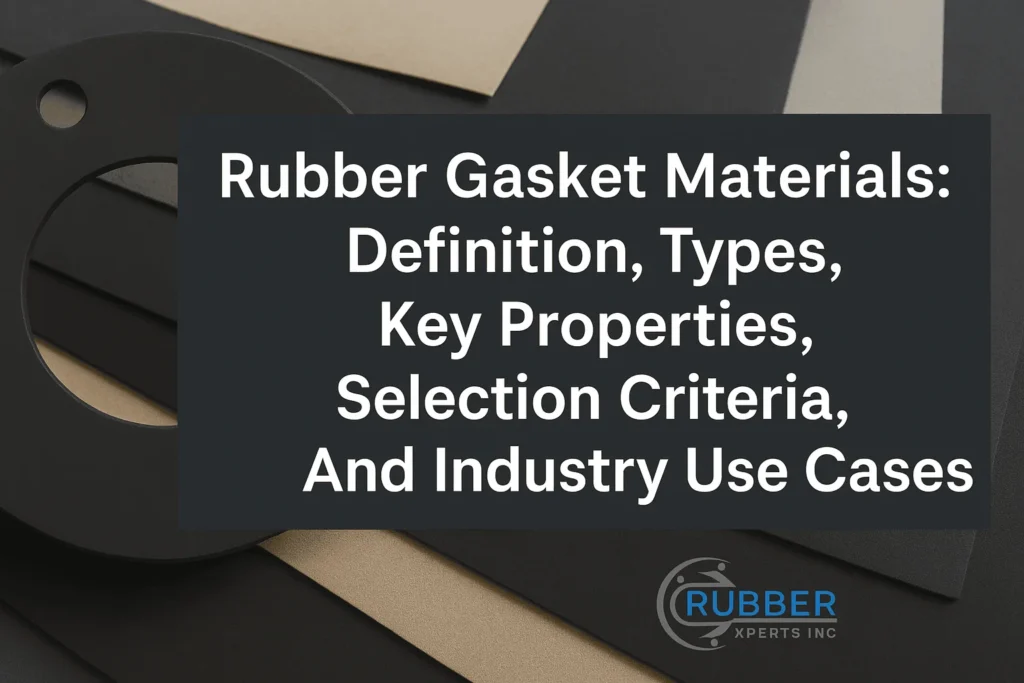Rubber, a versatile polymeric material derived from latex, demonstrates unique flexibility and elasticity that make it useful across many industries. There are various types, including natural rubber derived from rubber trees and synthetic rubber engineered for enhanced properties. These resilient elastomers cater to diverse applications, blending durability with adaptability. According to the World Rubber Organization (ANRPC), in 2022, the world consumed 29.7 million metric tons of rubber.
Rubbers are classified based on their origin, structure, and performance characteristics. Natural rubbers excel in elasticity and flexibility, while synthetic variants like nitrile, neoprene, and SBR are tailored for specific purposes, such as chemical or weather resistance. This classification ensures targeted solutions for industrial and consumer needs. According to a report by Statista, synthetic rubber had a market value of over 33 billion U.S. dollars as of 2024.
The innate properties of rubber, such as durability, chemical resistance, and weather resilience, make it a sought-after material globally. Its ability to adapt to stress and environmental factors enhances its utility in sealing applications, automotive parts, and industrial equipment, contributing to its high global demand.
Rubber manufacturing methods vary based on the type and intended use. Natural rubber is processed through tapping and coagulation, while synthetic variants are produced via polymerization techniques. Advanced vulcanization processes improve durability and elasticity, ensuring superior performance in demanding environments.
Rubber is used in various industries, from machinery sealing to electrical insulation and automotive parts. Its versatility supports its role as an important component for industrial equipment, consumer goods, and infrastructure. The material’s adaptability meets evolving industrial and environmental challenges, reinforcing its importance in modern life.
What is a Rubber?
Rubber is a natural polymer derived from the latex of rubber trees, primarily composed of hydrocarbon polymers like polyisoprene. Its viscoelastic properties allow it to stretch and return to its original shape, making it highly flexible and durable, better for applications requiring sealing, insulation, and cushioning in various industrial sectors.
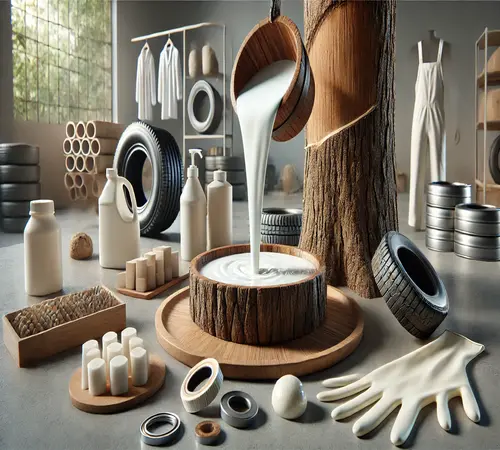
According to the American Chemical Society, rubber definition is “a material that, when stretched, returns to its original shape and size after the stress is removed,” making it highly elastic and suitable for various applications. Over time, the evolution of rubber has led to the development of vulcanized material, which enhances its elasticity, thermal stability, and resistance to wear, making it indispensable for modern industries.
Rubber is important for creating effective seals in flange connections in industrial sealing due to its amorphous structure, which allows it to conform to irregular surfaces. Its elastic polymer properties enable it to provide a tight, flexible seal that withstands pressure and temperature fluctuations. Sustainable rubber production methods and advances in eco-friendly rubber have contributed to the recycling of rubber and reducing the environmental impact of industrial rubber manufacturing.
The discovery of rubber during the Industrial Revolution marked a significant turning point in material science, offering a versatile solution for sealing and insulation in numerous industrial applications. Rubber’s ability to adapt to diverse conditions has made it a revolutionary industrial material, indispensable in sealing components for industries ranging from automotive to construction.
What are the Different Types of Rubbers?
The different types of rubbers are Natural Rubber, Synthetic Rubber, VulcanizedRubber, and Styrene Butadiene Rubber. Each type has distinct properties and applications in the rubber industry, such as seals and gaskets, consumer goods, and material engineering, as studied by Halim S et al. 2013, titled “Rubber types, properties and uses.”
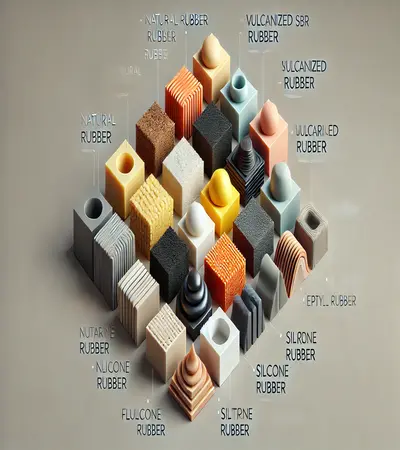
The different types of rubbers are as follows:
1. Natural Rubber
Natural rubber is a natural polymer derived from the latex of rubber trees (Hevea brasiliensis). It is primarily composed of hydrocarbon polymers, which exhibit elastic properties. Its amorphous structure allows it to be a highly resilient polymer, providing flexibility and strength in various applications.
This latex rubber is mainly found in countries like Brazil, India, Indonesia, Malaysia, and Sri Lanka. The polymerization makes it of isoprene (2 methyl-1, 3-butadiene), which has a chemical formula (C5H8) n, and it is known as cis- 1, 4- polyisoprene, as studied by Byjus in “Natural rubber and synthetic rubber.”
What is the Manufacturing Process of Natural Rubber?
The manufacturing process of natural rubber begins with tapping to extract latex from rubber trees. The latex is collected and then coagulated using acids or heat. The solidified rubber is washed, dried, and processed into sheets. The sheets are further treated to remove any impurities before being molded into the desired shapes. This process results in raw rubber, which is then further vulcanized for industrial applications. Sulfur is added to the rubber, and it is heated at a temperature ranging from 373 K to 415 K, a process known as vulcanization, which improves all these properties.
What are the Main Uses of Natural Rubber?
The main uses of natural rubber include applications in the rubber industry in tires, seals and gaskets, footwear, and industrial machinery. Its thermal stability and elastic properties make it outstanding for automotive and industrial applications, particularly seals and gaskets, where durability and flexibility are important.
Natural rubber is a key material for tires in the automotive sector. According to a study by Petrov R et al., 2022, “Durability and Elasticity of Natural Rubber in Industrial Applications,” its resilience and ability to absorb shocks contribute to improved performance and safety. Its resistance to abrasion and fatigue ensures long-lasting service in heavy-duty applications such as conveyor belts and vibration dampers in industrial machinery.
Natural rubber’s biodegradability and eco-friendly characteristics also make it a sustainable choice for products like surgical gloves and other medical applications, where its hypoallergenic properties are necessary, as studied by Revolutionized 2024, “The Benefits of Natural Rubber in Sustainable Manufacturing.” Its use in seals and gaskets is important for ensuring tight closures in mechanical and hydraulic systems, offering reliable performance even under high-pressure conditions.
2. Synthetic Rubber
Synthetic rubber is an artificial polymer created by polymerizing synthetic monomers, 1, 3—butadiene derivatives, or by copolymerizing 1, 3—butadiene with an unsaturated monomer. It mimics the properties of natural rubber but is engineered to have specific characteristics, such as improved resistance to wear and extreme temperatures.
What is the Manufacturing Process of Synthetic Rubber?
The manufacturing process of synthetic rubber begins with the polymerization of petroleum-derived monomers like butadiene and styrene. The monomers are polymerized in a reactor using a catalyst or heat. The resulting polymer is then compounded with carbon black, oils, and other additives to improve its properties. After mixing, the material is vulcanized to enhance strength, durability, and flexibility.
What are the Main Uses of Synthetic Rubber?
Synthetic rubber is mainly used in automotive components like tires, hoses, and seals. It is also used in industrial applications such as conveyor belts, gaskets, and seals. Its ability to withstand oils, fuels, and extreme temperatures makes it ideal for seals and gaskets in industrial applications. Depending on the type of synthetic rubber, it withstands temperatures from -40°C to +150°C, as studied by Bekkedahl S. et al., 1952, in their paper, “TNatural and Synthetic Rubbers.”
Synthetic rubber is a fundamental material for conveyor belts, vibration dampeners, and industrial sealing components. Its elasticity and chemical resistance enhance operational reliability. Types such as nitrile rubber and styrene-butadiene rubber (SBR) are used for seals and gaskets, as they maintain their integrity in contact with hydrocarbons and other harsh chemicals, according to a study by Xu L et al., 2020, titled “Current Status and Prospects of High-Performance Synthetic Rubber.”
Consumer products, including footwear, household appliances, and adhesives, also benefit from synthetic rubber due to its adaptability in texture and ability to be customized for various functions. Its recyclable materials nature and lower cost compared to natural rubber add to its widespread appeal in modern manufacturing.
3. Vulcanized Rubber
Vulcanized rubber has undergone a chemical process called vulcanization, in which sulfur is added to improve its elasticity, strength, and durability. This process involves heating the rubber and sulfur under pressure, creating cross-links between the polymer chains, according to a study by Yamano M et al. 2021, titled “Preparation and characterization of vulcanized natural rubber with high stereoregularity.”
What is the Manufacturing Process of Vulcanized Rubber?
The manufacturing process of vulcanized rubber starts with preparing the rubber compound, which includes mixing raw rubber with sulfur and other chemicals. The compound is then heated in a process called vulcanization, where the sulfur forms cross-links between the polymer chains, improving the rubber’s strength and elasticity. After vulcanization, the rubber is cooled, shaped, and molded into desired forms, such as seals and gaskets.
What are the Main Uses of Vulcanized Rubber?
The main uses of vulcanized rubber lie in industries demanding high durability, elasticity, and thermal stability. Its elastic material structure, improved through the vulcanization process, makes it indispensable in seals and gaskets, automotive tires, and industrial components. Vulcanized rubber is particularly valued in automotive applications, such as tire production, where it provides superior abrasion resistance, load-bearing capacity, and performance under extreme temperature conditions (-40°C to +150°C), as studied by Smith R et al., 2021, titled “Advancements in Vulcanized Rubber for Automotive Applications.”
In material engineering, heat-resistant rubber, such as vulcanized rubber, is valued for its resistance to heat, chemicals, and mechanical stress. This makes it ideal for conveyor belts, vibration dampeners, and industrial seals used in harsh environments. According to a study by Yale University in 2022, “What Is the Purpose Of Vulcanized Rubber?” It is also extensively used in components exposed to dynamic loads, such as O-rings and gaskets, which require a balance of flexibility and resistance to deformation over time.
Its applications extend to consumer goods, including footwear, elastic bands, and sporting equipment, where durability and elasticity are required. The process of vulcanization improves the material’s molecular bonds, reducing tackiness and improving mechanical properties, making it superior for high-performance requirements. Its biodegradability potential is also being explored for sustainable applications, aligning with modern environmental goals.
4. Styrene Butadiene Rubber (SBR)
Styrene Butadiene Rubber (SBR) is a synthetic rubber made by polymerizing styrene and butadiene. It is one of the most widely used synthetic rubbers, providing a balance of performance and cost-effectiveness.
What is the Manufacturing Process of Styrene Butadiene Rubber?
The manufacturing process of styrene butadiene rubber involves polymerizing styrene and butadiene in an emulsion or solution. The polymerization process is initiated using a free-radical catalyst, resulting in the formation of polymer chains. After polymerization, the rubber is compounded with stabilizers, carbon black, and other additives. The compound is then vulcanized to improve its strength and durability, making it suitable for a wide range of applications.
What are the Main Uses of Styrene Butadiene Rubber?
The main uses of Styrene Butadiene Rubber (SBR) span across various industries due to its exceptional abrasion resistance, thermal stability, and cost-effectiveness. In the rubber industry, SBR is a primary component in tire manufacturing, contributing approximately 40% of the total rubber content in modern passenger and truck tires. Its combination of elasticity and durability ensures superior performance under dynamic loads, making it perfect for tire treads and sidewalls, according to a study by Vedantu in “Styrene-Butadiene Rubber.”
In the automotive sector, SBR is used in gaskets, seals, and hoses, where its resistance to wear and ability to withstand moderate heat and chemical exposure are necessary. These properties ensure long-lasting sealing performance, particularly in systems exposed to variable pressures, such as brake fluids and fuel lines. In industrial applications, SBR is integral to conveyor belts and other high-stress mechanical components, where its tensile strength and resistance to cracking under repeated flexing are important.
SBR plays a significant role in consumer goods, such as footwear, sporting equipment, and adhesives. Its flexibility and resistance to deformation make it a preferred material in sports shoe soles and durable rubber bands. A study by Santana MH et al. 2018, titled “Design of a new generation of sustainable SBR compounds with good trade-off between mechanical properties and self-healing ability,” highlights SBR’s potential for sustainable sealing solutions, as advancements in polymer science enable recyclability without significant degradation in mechanical properties.
5. Butyl Rubber
Butyl rubber is a synthetic rubber made from the polymerization of isobutylene with a small amount of isoprene, as studied by Webb RN et al. 2003, titled “Butyl Rubber.” It is known for its excellent gas and moisture impermeability, making it suitable for airtight and watertight applications.
What is the Manufacturing Process of Butyl Rubber?
The manufacturing process of butyl rubber involves the polymerization of isobutylene and isoprene in the presence of a catalyst. The polymerization process occurs in a solvent or liquid phase, resulting in a high-molecular-weight rubber. The rubber is then compounded with antioxidants, processing oils, and other additives to improve its properties. The material is then vulcanized for further processing into desired forms, such as seals and gaskets.
What are the Main Uses of Butyl Rubber?
The main uses of butyl rubber are in applications where airtightness and moisture resistance are necessary. It is commonly used in seals and gaskets for automotive, medical, and industrial applications, as well as in inner tubes, tires, and roofing membranes. Its impermeability to gases and moisture makes it an outstanding choice for sealing components in challenging environments.
In the automotive sector, it is extensively used in inner tubes for tires, providing superior air retention compared to other rubber types. Its impermeability to gases ensures reliable performance in sealing components such as valves, gaskets, and engine seals, where maintaining pressure and preventing leaks is important.
In the medical field, butyl rubber is a fundamental material for producing pharmaceutical closures, such as stoppers for vials and syringes. Its low permeability to gases and moisture helps preserve the sterility and efficacy of medications.
The construction industry uses butyl rubber in roofing membranes and sealants. Its resistance to weathering, UV radiation, and moisture ensures long-term durability and thermal stability, as Sharma RK et al., 2021, “Advances in butyl rubber synthesis via cationic polymerization: an overview,” studied.
Butyl rubber is used in industrial applications for flexible hoses, vibration dampeners, and electrical insulation. Its viscoelastic properties and resistance to chemical exposure make it superior for these applications.
6. Neoprene Rubber
Neoprene rubber, also known as polychloroprene, is a synthetic rubber that is highly resistant to weathering, oils, and chemicals. It provides excellent durability and flexibility in harsh conditions, as studied by Woo DK et al. 2005, titled “Neoprene.”
What is the Manufacturing Process of Neoprene Rubber?
The manufacturing process of neoprene rubber involves the polymerization of chloroprene, which is initiated by a free-radical catalyst. The resulting polymer is then compounded with stabilizers, oils, and other additives. The compound is then vulcanized to improve its durability and flexibility, making it suitable for a wide range of applications, including seals and gaskets.
What are the Main Uses of Neoprene Rubber?
The main uses of neoprene rubber include sealing in automotive, construction, and industrial applications. It is used in seals and gaskets, particularly where resistance to oils, chemicals, and weathering is needed.
In the automotive sector, neoprene is a preferred material for seals, gaskets, and hoses that require durability and resistance to fuel and lubricants. Its construction applications include roofing membranes, expansion joints, and window seals, owing to its weather-resistant properties that ensure performance under extreme conditions.
Neoprene is integral in industrial applications, particularly conveyor belts, protective coatings, and vibration dampeners, where its flexibility and mechanical strength are required. According to a study by Interplas Insights, in “A Complete Guide to Neoprene Rubber,” its resistance to degradation from UV exposure and ozone makes it a reliable material in outdoor settings.
Neoprene is also used in consumer goods, including wetsuits, gloves, and orthopedic braces. Its excellent thermal insulation and elasticity make it suitable for protective clothing and sporting goods. Adding fillers like glass fibers improves its mechanical properties, making it even more versatile for demanding applicationsAccording to a study by Antypas I et al. 2021, titled “ Improvement of mechanical behavior of neoprene rubber by means of glass fiber.”
7. Silicone Rubber
Silicone rubber is a synthetic rubber made from silicon, oxygen, carbon, and hydrogen. It is known for its thermal stability, flexibility, and resistance to extreme temperatures and environmental conditions.
What is the Manufacturing Process of Silicone Rubber?
The manufacturing process of silicone rubber involves the polymerization of siloxane monomers in the presence of a catalyst. The polymer is then mixed with fillers and other additives to improve its properties. It is vulcanized using heat or a chemical curing agent to enhance its strength, flexibility, and thermal stability. The material is then molded into seals and gaskets for various applications.
What are the Main Uses of Silicone Rubber?
The main uses of silicone rubber are in seals and gaskets for high-temperature environments, medical devices, automotive engines, and kitchenware. All these applications require high thermal stability and flexibility. Its biodegradability and eco-friendly rubber properties make it a popular choice for sustainable production.
In industrial applications, it is widely used in seals and gaskets for machinery and equipment that operate under extreme temperatures, ranging from -60°C to 230°C. Its thermal stability makes it indispensable for high-performance industries such as aerospace and electronics.
In the medical field, silicone rubber is a preferred material for devices like catheters, implants, and tubing due to its biocompatibility, flexibility, and resistance to bacterial growth. Its non-toxic nature makes it suitable for food-grade applications, such as kitchenware, including baking mats and spatulas, where heat resistance and safety are important, as studied by Zare M et al., 202, titled “Silicone-based biomaterials for biomedical applications: Antimicrobial strategies and 3D printing technologies.”
Silicone rubber is also used in automotive engines for hoses, gaskets, and vibration dampers. It is durable and reliable under fluctuating temperatures and pressures. Its excellent insulation properties make it an important material in electronics, particularly for protective covers and thermal interface materials.
Emerging advancements in silicone formulations have promoted its use in eco-friendly applications. Its long lifespan and recyclable properties contribute to sustainable production practices. Innovations in polymer science are further optimizing its biodegradability and reducing its environmental footprint.
8. Nitrile Rubber
Nitrile rubber, also known as Buna-N, is a synthetic rubber made by polymerizing butadiene and acrylonitrile. It is known for its excellent resistance to oils, fuels, and solvents.
What is the Manufacturing Process of Nitrile Rubber?
The manufacturing process of nitrile rubber involves the polymerization of butadiene and acrylonitrile in an emulsion or solution process. The polymer is then compounded with carbon black, oils, and stabilizers to enhance its resistance properties. The material is vulcanized to increase its strength and flexibility, making it ideal for use in seals and gaskets.
What are the Main Uses of Nitrile Rubber?
The main uses of nitrile rubber are in seals and gaskets for automotive, aerospace, and industrial applications, as well as in consumer goods like gloves and hoses.
NBR is widely used in automotive fuel systems, oil hoses, and gaskets. Its hydrocarbon polymer structure offers superior performance in environments exposed to oils and extreme temperatures. In the aerospace industry, nitrile rubber is necessary for manufacturing fuel seals, hydraulic systems, and O-rings, where reliability and resistance to harsh chemicals are paramount.
Industrial applications include the production of conveyor belts, hoses, and seals for heavy machinery, where their durability and chemical resistance improve operational longevity. Nitrile rubber is also a fundamental material in protective gloves, particularly in medical and laboratory environments. It is resistant to punctures, oils, and solvents, offering robust protection while maintaining tactile sensitivity.
Nitrile rubber is used in consumer goods such as footwear and mats, benefiting from its abrasion resistance and flexibility. Emerging advancements in polymer science are further expanding its applications, particularly in sustainable and recyclable materials, enabling eco-friendly practices in industries relying on NBR.
9. Ethylene Propylene Diene Monomer Rubber (EPDM)
Ethylene Propylene Diene Monomer (EPDM) rubber is a synthetic elastomer made from a combination of ethylene, propylene, and a diene component. It is highly resistant to weathering, ozone, and UV radiation.
What is the Manufacturing Process of EPDM Rubber?
The manufacturing process of EPDM rubber involves the polymerization of ethylene, propylene, and a diene monomer. The polymer is then compounded with fillers, stabilizers, and accelerators before undergoing vulcanization to improve its strength and resistance to environmental degradation.
What are the Main Uses of EPDM Rubber?
The main uses of EPDM rubber include applications in the automotive and construction industries as roofing materials, seals, and gaskets. It is valued for its resilience and weather resistance, making it suitable for outdoor applications.
EPDM rubber is used in seals, gaskets, weatherstripping, and radiator hoses in the automotive industry. It endures extreme temperatures ranging from -40°C to +120°C and resists UV radiation, ozone, and environmental stress. Its elasticity ensures long-term sealing performance in vehicle doors, windows, and trunk systems.
EPDM is an important construction material for roofing membranes, window seals, and building insulation. Its superior waterproofing and thermal resistance properties make it a popular choice for flat roofing systems, which last over 50 years with minimal maintenance.
Industrial applications include HVAC systems, pipelines, and machinery seals. EPDM rubber’s resistance to water, steam, and polar substances ensures durability and reliability. It is also employed in marine applications for sealing hatches and windows, given its resistance to saltwater and UV exposure.
10. Fluorosilicone Rubber
Fluorosilicone rubber is a synthetic rubber made from a combination of silicone and fluorine. It is resistant to oils, fuels, and high temperatures, making it perfect for the aerospace and automotive industries.
What is the Manufacturing Process of Fluorosilicone Rubber?
The manufacturing process of fluorosilicone rubber involves the polymerization of siloxane monomers with fluorinated compounds. The resulting soft polymer is compounded with additives and vulcanized to improve its strength, flexibility, and chemical resistance.
What are the Main Uses of Fluorosilicone Rubber?
The main uses of fluoro silicone rubber are in aerospace and automotive applications where resistance to fuels, oils, and high temperatures is required. It is used in automotive fuel injector seals, turbocharger hoses, and emission system components. Its resistance to automotive fluids, such as diesel and gasoline, and its thermal stability make it suitable for modern fuel-efficient and high-performance engines.
Industrial applications include the use of fluoro silicone in chemical processing equipment seals and gaskets, where contact with aggressive solvents and high-pressure environments is common. It is also employed in medical devices, where its biocompatibility and resistance to sterilization processes make it appropriate for seals and gaskets in equipment exposed to harsh cleaning agents.
Its application in seals and gaskets for oil and gas exploration equipment highlights its durability under extreme mechanical and chemical stresses. The development of recyclable materials in fluoro silicone production is also contributing to its role in sustainable material engineering.
When to Use Different Kinds of Rubber Materials?
Different kinds of rubber materials are used based on their properties and the requirements of the specific application. Each rubber type offers distinct advantages depending on factors such as temperature, chemical resistance, flexibility, and durability.
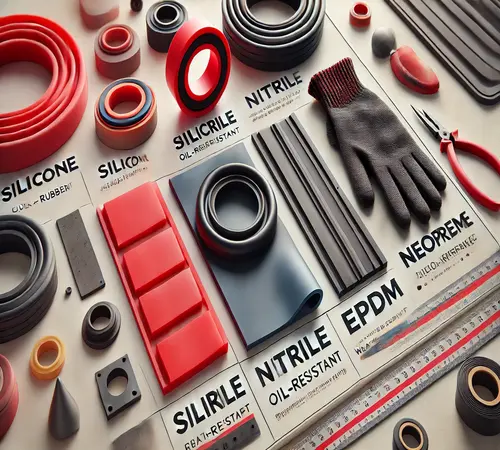
The following table discusses 10 types of rubber materials and their uses:
|
Type of Rubber |
Properties |
Common Uses |
|
Natural Rubber |
High elasticity, excellent tensile strength, and flexibility. |
Automotive tires, industrial machinery, seals and gaskets, footwear, and hoses. |
|
Synthetic Rubber |
Superior to natural rubber in resistance to oils, chemicals, and heat. |
Automotive parts (tires, seals, hoses), industrial belts, and conveyor systems. |
|
Vulcanized Rubber |
Enhanced durability, heat resistance, and chemical resistance. |
Seals, gaskets, automotive tires, industrial components, and hoses. |
|
Styrene Butadiene Rubber |
Good abrasion resistance, high-performance rubber, and low-temperature flexibility. |
Automotive tires, belts, gaskets, footwear, and sporting equipment. |
|
Butyl Rubber |
Excellent air and moisture impermeability, good chemical resistance. |
Inner tubes, medical seals, roofing membranes, and automotive seals. |
|
Neoprene Rubber |
Resistance to oils, chemicals, weather, and heat. |
Seals, gaskets, wetsuits, and protective clothing. |
|
Silicone Rubber |
High thermal stability, flexibility, and chemical resistance. |
High-temperature seals, medical devices, kitchenware, and electrical insulation. |
|
Nitrile Rubber |
High resistance to oils, fuels, and solvents. |
Automotive seals, gaskets, hoses, and gloves. |
|
EPDM Rubber |
Excellent weather, ozone, and UV resistance. |
Automotive weather stripping, roofing membranes, seals, and gaskets. |
|
Fluorosilicone Rubber |
Resistance to high temperatures, oils, and fuels. |
Aerospace seals, gaskets, and fuel system applications. |
Which Type of Rubber is Best to Use?
The type of rubber best suited to an application depends on its specific requirements, including factors such as temperature range, chemical exposure, flexibility, and durability.
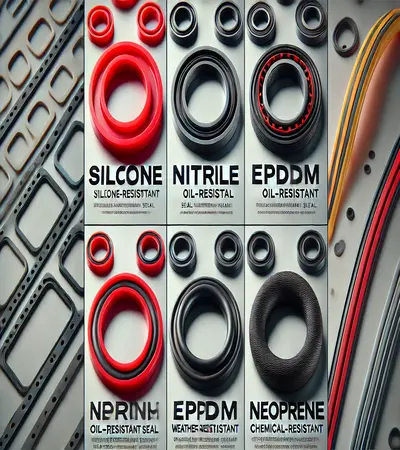
Silicone rubber is excellent for applications requiring high-temperature resistance due to its outstanding thermal stability. Nitrile rubber is preferred for applications involving oil or fuel exposure because it is resistant to hydrocarbons. EPDM rubber is the best choice for outdoor applications exposed to UV light and ozone, while neoprene is chosen for its chemical and weather resistance.
What is Vulcanization and Rubber Compounding?
Vulcanization is a chemical process that involves heating rubber with sulfur to improve its elasticity, strength, and durability. This process creates cross-links between polymer chains, making the rubber more resistant to wear, heat, and environmental factors.
Rubber compounding refers to the formulation of rubber mixtures with various additives, such as fillers, plasticizers, curing agents, and stabilizers, to achieve specific properties. Compounding allows manufacturers to customize rubber for different applications, enhancing characteristics such as hardness, flexibility, or chemical resistance.
What are Die-cut and Molded Rubber Parts?
Die-cut and molded rubber parts are methods of shaping rubber into specific forms for various applications. Die-cut rubber parts are created by cutting rubber sheets into predetermined shapes using a die press. This method is ideal for producing parts with simple shapes and moderate quantities.
Moldable rubber parts are formed by placing rubber compounds into molds, where they are heated to cure and take the mold’s shape. This technique allows for more complex shapes and is better suited for large production runs or intricate designs. Both methods are used to produce seals, gaskets, washers, and other rubber components used in diverse industries.
What are the Benefits of Using Rubber Material?
The benefits of using rubber material are flexibility and elasticity, water and weather resistance, and insulation properties. These qualities make rubber necessary in a wide range of industrial and consumer applications.
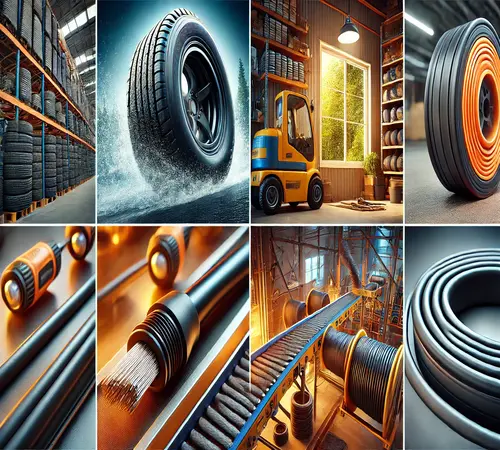
The benefits of using rubber material are as follows:
- Flexibility and Elasticity: Rubber is an inherently elastic and flexible material, allowing it to stretch and return to its original shape. This makes it suitable for applications that require constant movement or compression, such as seals, gaskets, and automotive components. Its ability to absorb shocks and adapt to different shapes ensures reliable performance in dynamic environments.
- Water and Weather Resistance: Rubber materials, especially synthetic polymers like EPDM and neoprene, are highly resistant to water, UV rays, and extreme weather conditions. This makes them perfect for outdoor applications, such as roofing membranes, automotive weatherstripping, and marine seals. Rubber’s weather resistance ensures long-term durability, even under harsh conditions.
- Insulation Properties: Rubber’s excellent insulation properties make it a pivotal material for electrical applications. It is also used for wire and cable coatings to prevent electrical conduction and ensure safety. Rubber’s thermal insulating properties help to reduce heat transfer, making it valuable for HVAC systems and in applications where temperature control is required.
- Abrasion Resistance: Rubberized compounds are highly resistant to abrasion, ensuring longevity and performance even in high-friction environments. It is frequently used in conveyor belts, tires, and industrial machinery, where it withstands wear and tear from constant use. This resistance makes rubber a good choice for applications requiring a durable surface.
- Non-slipQualities: Its rubberized surface texture makes it an excellent non-slip material, which is important in areas where safety is a priority. Rubber mats, footwear, and seals incorporate these properties to prevent slipping, particularly in wet or oily environments. Its grip is useful in both industrial and consumer products.
- Sound and Vibration Damping: Rubber effectively absorbs sound and vibration, reducing noise and minimizing movement. This makes it excellent for use in machinery, automotive parts, and soundproofing applications. Its ability to dampen vibrations also improves comfort and performance in sensitive environments like medical equipment or high-precision tools.
- Recyclability: Rubberized Elastomer, especially synthetic types like butyl rubber and SBR, are recycled and repurposed, making it a more sustainable material choice. Recycled rubber is used in various applications, such as flooring, playground surfaces, and automotive parts, contributing to eco-friendly manufacturing practices. Its recyclability reduces waste and supports the push for sustainable production in the rubber industry.
What are the Most Common Rubber Products?
The most common rubber products are rubber O-rings, rubber pipes, and rubber extrusions & profiles. These products are widely used in various industries, from automotive to industrial applications, due to their versatile properties and ability to provide effective sealing solutions.
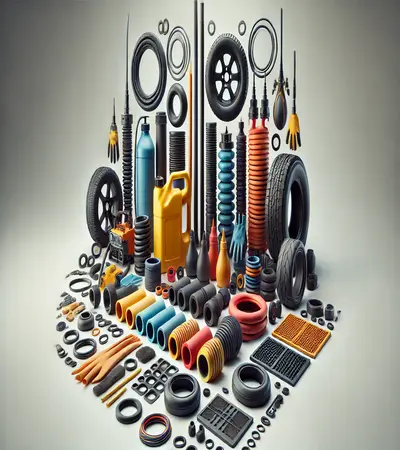
The most common rubber products are as follows:
- Rubber O-rings: Rubber O-rings are circular seals made from flexible rubber materials commonly used to prevent leakage in mechanical systems. They are found in applications such as automotive engines, hydraulic systems, and plumbing. Rubber O Rings form a tight seal under pressure, making them indispensable in maintaining fluid and gas containment.
- Rubber Pipes: Rubber pipes are flexible tubes used to transport fluids, gases, or other materials. They are known for their durability and resistance to abrasions and are commonly employed in industrial processes, agricultural systems, and automotive applications. Rubber pipes offer excellent flexibility, making them suitable for environments with dynamic movements.
- Rubber Extrusions & Profiles: Rubber extrusions and profiles are custom-made rubber products shaped using the extrusion process. They are used in various applications, including automotive weather seals, door seals, and industrial machinery. Rubber extrusions’ flexible nature and adaptability make them vital for ensuring a tight fit and durability in sealing applications.
- Rubber Gaskets: Rubber gaskets prevent leaks between mating surfaces by providing a reliable seal. They are commonly used in engines, pumps, and industrial machinery. Rubber gaskets resist chemicals, heat, and pressure, making them indispensable for maintaining performance and safety.
- Rubber Seals: Rubber seals prevent the ingress of dust, moisture, or other contaminants into mechanical systems. Rubber seals are used in automotive, construction, and marine applications to maintain the integrity of machinery and enhance its lifespan.
- Rubber Mounts: Rubber mounts reduce vibration and noise in machinery. They are found in vehicles, industrial equipment, and machinery, helping to absorb vibrations and maintain operational efficiency. Their ability of rubber mounts to provide cushioning while maintaining stability makes them highly valued in various mechanical systems.
- Rubber Hoses: Rubber hoses are flexible tubes used to transport liquids, gases, or powders. They are commonly found in industrial, automotive, and construction settings. Their durability, flexibility, and resistance to chemicals make rubber hoses good for high-performance applications.
- Rubber Bushings: Rubber bushings are used to reduce vibration and noise in mechanical systems. They are commonly used in automotive suspension systems, machinery, and industrial applications. Rubber bushings help improve comfort and stability by providing isolation between moving parts.
- Silicone Rubber Products: Silicone rubber products are prized for their high-temperature resistance and electrical insulating properties. They are commonly used in the medical, automotive, and food industries. Silicone rubber offers flexibility, durability, and resistance to environmental stress, making it excellent for applications requiring exceptional performance.
- Silicone All-Purpose Sealant: Silicone all-purpose sealant is a versatile adhesive and sealant commonly used in construction and home improvement projects. It is highly effective for sealing windows, doors, and other openings, providing waterproof and airtight seals. The long-lasting durability and resistance to the weather make silicone all-purpose sealant a popular choice for both indoor and outdoor sealing applications.
What Industries Rely on Rubber Products?
The industries that rely on rubber products are automotive, construction, and manufacturing. Rubber products offer durability, flexibility, and performance under demanding conditions. Their ability to withstand wear, resist chemicals, and perform in extreme temperatures makes them important for various applications across these industries.

The following industries rely on rubber products:
- AutomotiveIndustry: Rubber products are fundamental in the automotive sector, where they are used in tires, seals, gaskets, hoses, and suspension components. Automotive manufacturers depend on rubber to ensure performance, safety, and reliability under harsh driving conditions. Thermoplastic rubber offers improved durability and flexibility.
- Construction Industry: Rubber products such as seals, gaskets, and roofing membranes are used in the construction industry. Rubber’s weather resistance and flexibility make it a prime choice for sealing doors, windows, and structures exposed to the elements. Its insulation properties also contribute to building energy efficiency.
- Manufacturing Industry: Rubber products are integral to various manufacturing processes, particularly machinery, conveyor belts, and seals. Rubber’s abrasion resistance and ability to withstand high pressure and temperature fluctuations make it indispensable for maintaining smooth and efficient factory operations. Elastic sheeting offers flexibility in sealing and protection, while rubber blends provide customized solutions for diverse industrial requirements.
- AerospaceIndustry: The aerospace sector relies heavily on rubber components, particularly for sealing, vibration damping, and insulation. Rubber substance is used in gaskets, O-rings, fuel seals, and vibration isolators. Its ability to perform in extreme temperatures and resist chemicals makes it necessary to ensure the safety and longevity of aircraft components.
- Medical Industry: Rubber products are important in the medical sector, particularly in the production of gloves, seals, gaskets, and tubing. Their flexibility, impermeability, and sterilization capacity make rubber ideal for devices that require sanitary conditions, such as syringes, catheters, and IV equipment. Rubber’s biocompatibility ensures its safety for use in medical applications, reducing the risk of contamination.
What Steps and Precautions Should Be Taken for Proper Installation of Rubbers?
The steps and precautions that should be taken for proper installation of rubbers include proper surface preparation, correct selection of rubber type, and proper alignment. These precautions ensure that rubber products, such as seals, gaskets, and hoses, perform optimally and last longer in their applications.
The following steps and precautions should be taken for proper installation of rubbers:
- Proper Surface Preparation: Before installing rubber components, it is important to clean the surfaces where the rubber will be applied. Any dirt, grease, or moisture should be removed to ensure a strong bond. Surface preparation also involves checking for any sharp edges that damage the rubber during installation.
- Correct Selection of Rubber Type: The right type of rubber must be chosen for the specific application. Factors such as temperature, chemical exposure, and mechanical stress must be considered. Using the wrong rubber material can lead to premature failure and reduced performance in seals, gaskets, or other rubber components.
- Ensuring Proper Alignment: Proper alignment is required when installing rubber products, especially seals and gaskets. Misalignment leads to leaks, mechanical failure, or reduced sealing efficiency. Alignment should be checked before tightening fasteners or securing the rubber components.
Does Rubber Products Require Maintenance After Installation?
Yes, rubber products require maintenance after installation. Regular inspection and cleaning are necessary to ensure that rubber components, such as seals, gaskets, and hoses, continue to perform effectively. Rubber degrades over time due to environmental exposure, wear and tear, or chemical interaction. Proper maintenance, including lubrication, cleaning, and replacing worn parts, helps extend the lifespan of rubber products.
Are Rubbers Resistant to All Chemicals?
No, rubber is not resistant to all chemicals. While rubber materials are resistant to many chemicals, they are degraded by certain substances. For example, natural rubber is not resistant to oils, gasoline, or strong acids, while nitrile rubber offers better resistance to oils and fuels. Each type of rubber can withstand a specific set of chemicals, and exposure to incompatible substances leads to swelling, cracking, or complete degradation of the material.
Why Are Rubbers Called Elastomers?
Rubbers are called elastomers because they are highly elastic polymers capable of returning to their original shape after being stretched or compressed. This property is due to rubber’s amorphous structure, which allows it to deform under stress and revert to its original form once the stress is removed. The term “elastomer” is derived from “elastic” and “polymer,” emphasizing their nature as stretchable materials that extend and return to their original shape. This unique property makes them ideal for applications requiring both flexibility and durability.
Where to Get Customized Rubbers?
You can get customized rubbers from specialized manufacturers like Rubberxpert, which tailor rubber products to meet specific requirements in various industries. These manufacturers design and produce rubber seals, gaskets, hoses, and more, ensuring they meet performance needs such as temperature, chemical resistance, and mechanical stress.

